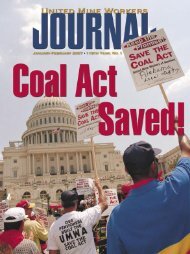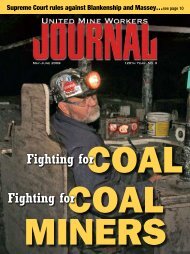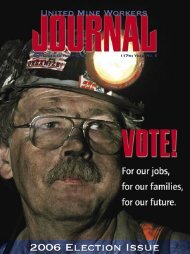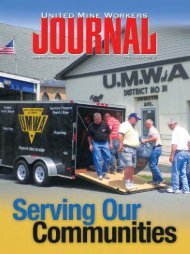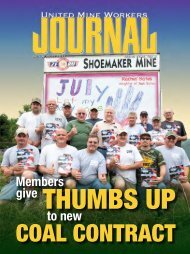March - April - United Mine Workers of America
March - April - United Mine Workers of America
March - April - United Mine Workers of America
- No tags were found...
You also want an ePaper? Increase the reach of your titles
YUMPU automatically turns print PDFs into web optimized ePapers that Google loves.
Governmentin actionJapanese earthquake and tsunami raisequestions about safety <strong>of</strong> nuclear powerThe incredibly powerful earthquakeand resulting tsunamithat devastated northeastern Japanin early <strong>March</strong> left thousands deadand hundreds <strong>of</strong> thousands homeless.It also caused what is still unfoldingas the worst nuclear powerdisaster in history.With several reactors releasinglarge amounts <strong>of</strong> radiation, Japanese<strong>of</strong>ficials ordered a complete evacuation<strong>of</strong> an area 19 miles outside theFukushima power plant. <strong>America</strong>ndiplomats advised <strong>America</strong>n citizensto move at least 50 miles away fromthe crippled plant.“ The spent fuelfrom a nuclear plantis still deadly forthousands <strong>of</strong> years.”Reports <strong>of</strong> contaminated food,water and milk are growing in Japan.Although it is highly unlikely thatany significant amount <strong>of</strong> radioactivecontamination will reach the <strong>United</strong>States, there is significant radiationbeing detected <strong>of</strong>f Japan’s coast, raisingquestions about the impact onsea life.Within days <strong>of</strong> the disaster,governments around the world beganstepping back from supporting newdevelopment <strong>of</strong> nuclear power in theircountries. Germany said it would shutdown older reactors. Slowdowns inlicensing procedures and enhancedsafety inspections were immediatelyput in place in France, Switzerland,Thailand, India and China.In the <strong>United</strong> States, where severalnuclear reactors sit on top <strong>of</strong> orwithin 50 miles <strong>of</strong> major fault lines,questions are being raised about thesafety <strong>of</strong> the reactors currently inuse as well as about how new plantscould be built that would be safe.Government regulators and thecompanies operating the U.S. nuclearplants have repeatedly said the plantsare safe. But concerns linger.“let’s face it, nuclear energy hassome pretty significant downsidesto it,” Secretary-Treasurer Kane said.“And it’s not just in those times whenthings go wrong.“The spent fuel from a nuclearplant is still deadly for thousands <strong>of</strong>years,” Kane said. “That means thatlong after all the coal is gone, longafter all the oil and natural gas aregone, people are still going to haveto contend with preventing deadlynuclear waste from contaminatingour environment and threateningpeople and wildlife.“That needs to be part <strong>of</strong> theequation as our nation looks to builda long-term, viable and realistic energypolicy that will serve us into thefuture,” Kane said. “Nobody’s reallybeen talking about that up to now.But it’s time we started.”You can help theJapanese disastervictimsThe <strong>America</strong>n Red Cross is acceptingdonations that will go directly to Japaneserelief efforts. Contact your local Red Crossor go to www.redcross.org and click on“How to Help.” Save the Children, whichis the world’s largest independentchildren’s assistance organization,has sent a team to Japan to help withrelief efforts. You can contact themby calling 1-800-728-3843, or go towww.savethechildren.org. <strong>United</strong> <strong>Mine</strong> <strong>Workers</strong> Journal • <strong>March</strong>/<strong>April</strong> 2011 15



